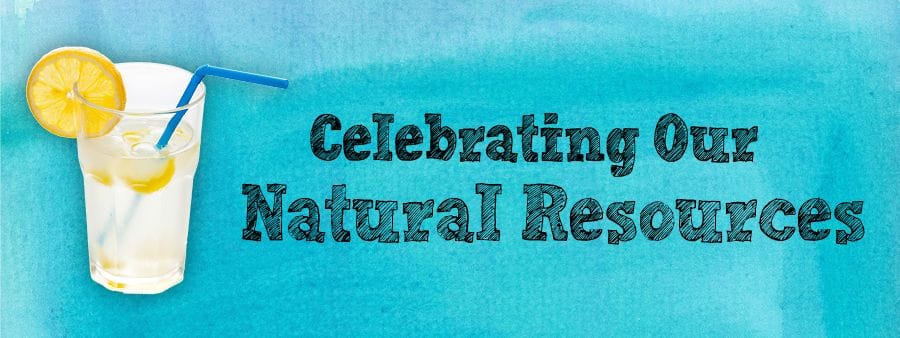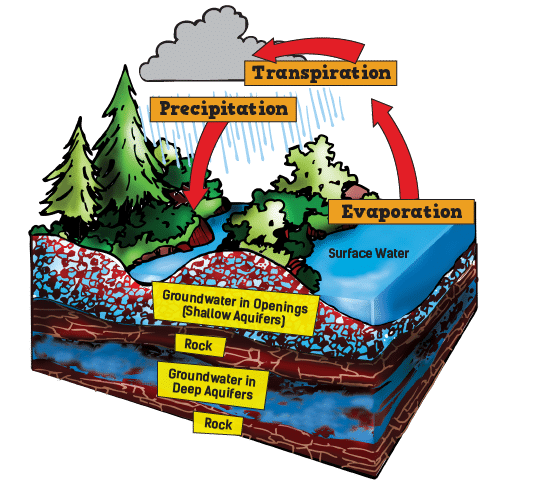Celebrating Our Natural Resources

Water
Where Does Our Water Come From?
 Water is so important for agriculture. Plants need it to grow. Animals need it to live. But where does it come from? Water comes to us through precipitation in the form of rain or snow. The water moves through our landscape in rivers, lakes, wetlands, and groundwater. Groundwater is water that exists underground. The biggest use for groundwater is to irrigate crops. That is why groundwater is important for agriculture.
Water is so important for agriculture. Plants need it to grow. Animals need it to live. But where does it come from? Water comes to us through precipitation in the form of rain or snow. The water moves through our landscape in rivers, lakes, wetlands, and groundwater. Groundwater is water that exists underground. The biggest use for groundwater is to irrigate crops. That is why groundwater is important for agriculture.
That is also why it is important for groundwater to be clean. Aquifers are underground areas that are made of gravel, sand, or fractured rock. When water moves through an aquifer, the aquifer acts like a filter. It helps take impurities out of the water. Aquifers can be small or large. Sometimes we find water just a few feet below the ground. Other times the water may be hundreds of feet deep. No one knows for sure how much water is in our aquifers. It is affected by how much rain we get and how much water we pump from wells. Today 75% of Minnesota’s drinking water and nearly 90% of the water used in crop irrigation is pumped from groundwater aquifers.
Protecting the Water
In Minnesota, there is a program called the Minnesota Agricultural Water Quality Certification Program. Farmers who are interested in protecting water sources on or near their farms can apply for certification. Certification is like earning a driver’s license. It means they have learned how to make fishing, swimming, and drinking water better for everyone. To earn certification, the farmers need to follow a number of requirements for how they conserve their land and water.
How do you like taking a shower in the same water molecules the dinosaurs waded in?
It’s true! The water we use today is the same water that has been recycled for millions of years since the earth was formed. We will never have any MORE water. That’s why we need to keep our water clean. We want it to be safe for all human uses and for aquatic creatures, too.
Cool Water Facts
There is the same amount of water on earth as there was when the earth was formed.
75% of the human brain is water, and 75% of a living tree is water.
Water expands when it freezes, making it less dense. That is why ice floats in water.
Water helps to regulate the temperature of large things, like the Earth, and smaller things, like the human body.
Soil
Why is Soil Important?
Farms need soil to grow plants. Soil holds roots in the ground so plants don’t fall over or blow away. It also helps plants absorb moisture, and it holds minerals and nutrients that plants use for food. Soil is also home to other living things helpful to plants. Some of those plants are used to feed animals. The soil beneath our feet is as important as the air we breathe and the water we drink. Farms and forests make up two-thirds of our state’s landscape. Who should care for the soil? Farmers and foresters have a big role to play. But we must also help. Here are things we all can do:
- Cover bare soil with new plants or mulch so soil won’t wash or blow away.
- Stay on sidewalks and trails.
Air
Take a deep breath. Can you tell the difference between fresh air and polluted air?
Plants and animals grow and thrive better with clean air. Air moves, so polluted air can blow in from near and far. There are many people who work hard to clean up the air. Car makers build engines that pollute less. Laws set rules for companies to dispose of waste. Many people— including farmers—are making electricity from cleaner, renewable energy sources instead of coal or petroleum. They are using solar power, wind, and field crops as energy sources for our cars, homes, and factories. It all adds up to cleaner air!
Thanks, plants!
Did you know that green plants help to clean air? They take in carbon dioxide, trap fine dust, and release oxygen during photosynthesis. Those green plants include grasses on prairies, algae in oceans, crops in fields, and trees in forests. About one-third of the oxygen released comes from grasses and other non-woody plants. One-third comes from ocean plants. Another third comes from forests. Take a breath—and thank the plants!
